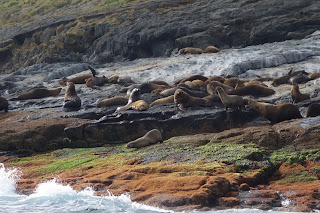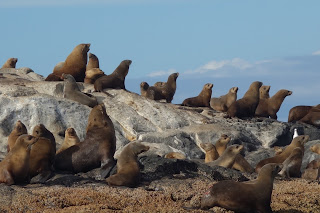I started my day on Saturday by going to Montague Island - on a charter fishing boat out into the Tasman Sea. Our Captain was Andy - and here you can see him at the wheel.
A little while later and Andy seems to be missing...
Montague Island is 9 kilometres offshore from Narooma. It was first sighted by James Cook and named Cape Dromedary, it was then later identified as an island and named by the master of the Second Fleet convict transport Surprize after George Montagu-Dunk, 2nd Earl of Halifax.
To local Aboriginal people, and many others as well, the island is known as Barunguba, and is the eldest son of Gulaga (Gulaga is on the mainland) and a brother to Najunuka (a smaller mountain at the feet of Gulaga). This long-time Aboriginal connection with the island is recorded through oral histories and physically by the archaeological record on the island itself. This evidence records that the island was used by the local people for traditional ceremonial purposes and also as a source of food. The island is still regarded as an important mens' teaching place.
Montague Island is actually two separate islands, with the north island being managed by local Aboriginal peoples. Visitors are not allowed on the north island.
Today the south section of Montague Island is entirely a Nature Reserve, and one of the major highlights of visiting the island is it's fur seal colony. Viewed from the boat around the northern edge of the island, hundreds can be regularly spotted.
Two species of fur seals are year-round inhabitants. The more numerous Australian Fur Seal is distinctive for its behaviour of sitting in tightly-packed groups on the rocks, often partly on top of neighbouring seals. New Zealand Fur Seals intermingle with the Australian Fur Seals but have a "body space" around them and are likely to bite any seal who gets too close.
Fur seals cool down by rolling on their side on the water's surface and waving a flipper in the air... and here I thought they were all giving me a friendly wave. And for as many seals as I saw on the rocks it seemed like there were equally as many just playing about in the water.
Because Montague Island is a Nature Reserve you can only visit as part of an organized tour - no other water craft are allowed to land on the island.
The southern section of the island is a significant historic place. Over 125 years of lightkeeping are represented on the island by the lighthouse tower, the keepers quarters and associated features such as sheds, gardens, tracks and jetties.
The lightstation and lighthouse were conceived in 1873 but monies were not allocated for several years. Construction was eventually completed after some problems and the lighthouse was officially commissioned in 1881. The entire lightstation retains most of its original form and fabric and has changed little from the time of construction to the present day.
The lighthouse and keepers quarters were designed by the colonial architect James Barnet. It was automated in 1986 and de-manned in 1987. The lighthouse is 21 metres tall and the light is 80 metres above sea level with a nominal range of 20 nautical miles (37 km) and a geographic range of 17 nautical miles (31 km).
We were allowed to go up the lighthouse, and from the top this is the view back towards the mainland and Gulaga,
and looking north over the whole island.
The Lighthouse Head Keeper's cottage and two assistant Lighthouse Keeper's cottages were also built in 1881 and today these have been fully restored and they are available for accommodation. A Parks and Wildlife Ranger lives permanently on the island and arrangements can be made for visitors to rent accommodation as well.
A small cemetery contains the graves of two children and one Assistant Keeper, all of whom died on the island in the period 1888 to 1894.
The island is also home to a large colony of Little Penguins. As the island has no foxes or feral cats, the penguins have no predators other than other sea birds and seals. With the restoration of native habitat and the provision of penguin breeding boxes, penguin numbers have increased, and there are now approximately 12,000 on the island.
One very special penguin breeding box was built, equipped with solar panels and a satellite dish. Although (obviously) built as a 'joke' for visitors to the island, there is actually a Mr. and Mrs. Ralph who have taken up residence in this luxurious accommodation.
Although there are very few penguins on the island at this time of year (they are off foraging at sea), we were fortunate to get this peak inside a breeding box at a few baby penguins that are still there. The two, fluffy, grey chicks are the two that actually belong in the box - and they are likely still being fed by their parents. The third one, the one that is more bluey-black in colour (in the middle), is older and its parents have likely stopped feeding it - so it 'moved in' with the two younger chicks in the hopes of continuing to get fed.
Saying good-bye to Montague Island, the seals and the penguins.
After my trip to Montague Island I went back to Broulee again in the afternoon and I did some more walking along the beaches there. Previously I showed you a couple photos of the North Broulee beach and here it is again but this time from further south along the beach.
If you were to walk around the headland you can see in the photo above you would come to this little cove and beach, Shark Cove. (Try as I might I didn't see any sharks at all 😕.)
Although I did go swimming this afternoon one had to be a bit careful as Bluebottles were unwelcome guests in the water today. Its venomous tentacles are the part that deliver quite a powerful sting.
Tonight I had the opportunity to participate in a real "Aussie" experience - a bush concert. Nerrigundah is a very little community located about 40 kms from Narooma, a bit north and then inland. Although it has a population of less than 100 there is a huge, memorial obelisk there - literally in the middle of nowhere. On April 8th, 1866, Thomas Clarke and his gang of bushrangers were in the area and had spent the day robbing passing travellers. Constable O'Grady who was very seriously ill (probably with cholera), dragged himself out of his sick bed to help deal with Clarke and his gang. In the ensuring battle O'Grady was shot and killed and this monument in the "centre of town" commemorates O'Grady's bravery.
Gotta love the "centre of town" - but at least there was a working pay phone in case anyone might need one.
I was in Nerrigundah to go to a concert that evening, at the Nerrigundah Agricultural Bureau,
which now has lights at the toilets!
Quite seriously, this was the venue for the concert, where we saw two members of "The Beez" - a musical band from Germany. They are usually a four member band but one of the band members has recently had a baby, so while the band is temporarily on "maternity leave", these two are touring on their own. Since one of them is originally from Australia, touring in Australia seems quite logical - although how they ended up in Nerrigundah ... ??? (for more information about the band check out www.thebeez.de)




























No comments:
Post a Comment